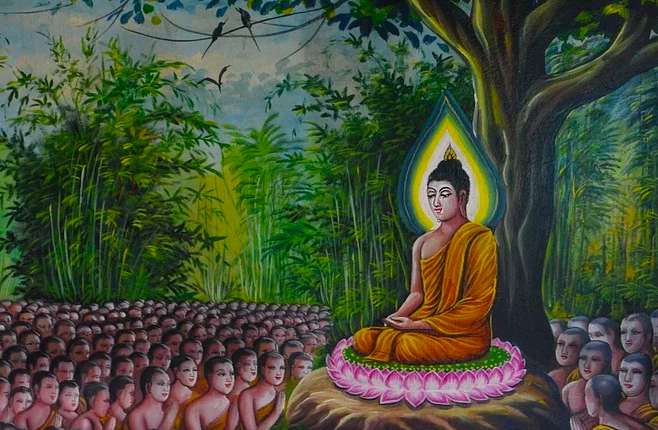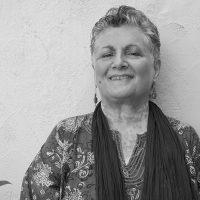In September 2018, at a conference centre in Mehrauli in south Delhi, India, I slipped and fell on a wet, grassy path.
I couldn’t get up, not even with help. It felt serious. Later at the hospital, I learned I had broken the tibia in the right leg in three places.
It was not a good time to break a leg. It was the second day of my five-day art exhibition; a group show with three other artists.
Lying on the wet grass, I messaged my colleagues at the exhibition that I wouldn’t be coming in and gave instructions for various things to be done. I called my doctors and my husband.
The driver of the ambulance who took me to the hospital drove carefully over bumps on the road, at my request. At the hospital, I was met by my husband. My leg was X-rayed immediately and plastered. My orthopaedic surgeon arrived, looked at the X-rays, and asked for me to be shifted to the hospital where he did his surgeries.
I was moved again. Lying in the emergency room, my mind raced in many directions. What would happen at the exhibition? Who would answer questions related to my artwork? How would the others manage? What about my exhibition in Amritsar next month?
I was in a lot of pain, but I was well taken care of, that night and the three days following surgery at the hospital. At home, a friend sent a wheelchair, which was too large to go into the bathroom. The next day, another friend brought over his father’s more compact wheelchair.
My husband, son, and our staff waited on me hand and foot. Over the weeks and months, neighbours, family, and friends called, visited, and we spent many happy hours sharing meals, stories, and laughter.
As the weather grew cooler, I moved toward the terrace, enjoying the greenery, birds, and butterflies. My leg healed, slowly.
By March, I was moving around a bit with a walker and then a stick. Slowly, driving and going out on my own. It felt good to be on my two feet.
However, one of my bones was not fusing. The doctor discussed the possibility of a graft. I didn’t want another surgery. But, by October, the CT scan showed no fusion and the rod and screws in my leg were looking unstable.
Surgery was imminent. I was upset by what loomed ahead—another surgery, and months of recovery.
My son was to be married in November, and I was dismayed by the fact I’d be in a wheelchair and absent from many of the pre and post-marriage activities. But I had no choice. The surgery was done in October. I was back in the wheelchair. The upside was I knew what was ahead in the long months of recovery.
So, what kept me going during this period?
My Buddhist mindfulness practices. I accepted what had happened to me and when I felt sorry for myself or negative feelings came up, I was aware of them, I breathed, and brought to my mind all the good things that had happened during this period and the kindness I had received.
When I was frustrated that I couldn’t go out or do what I wanted to, I turned to the things that gave me joy at home—my terrace, music, books, writing, painting, artefacts, and the light and the greenery I saw through the windows. I appreciated all these more than I ever had when I was on my two feet. I began to enjoy the silence of the home and the calm it brought me.
I realised that my suffering was an opportunity to accept the kindness of others around me, and to be happy at my good fortune. As Thich Nhat Hanh, the Zen Buddhist monk, whose teaching and practice I follow, says:
“If we focus exclusively on pursuing happiness, we may regard suffering as something to be ignored or resisted. We think of it as something that gets in the way of happiness. But the art of happiness is also the art of knowing how to suffer well. If we know how to use our suffering, we can transform it and suffer much less. Knowing how to suffer well is essential to realising true happiness.”
I would say I learned to suffer well. I have had several health challenges since I started the mindfulness practice in 2008 and even before. There have been surgeries, hospitalisations, and a great deal of physical discomfort and pain. These have stopped me in my tracks, unable to work and deliver on contracts, be homebound, and bedridden. I have felt anger, frustration, helplessness, and hopelessness.
But when I was going through these episodes, I returned to my breath. I turned my mind to the positive is my life, while recognising my suffering, knowing it would pass. My mind and heart would fill with love and gratitude for what others had done and were doing for me. And I found that as I treated others with compassion and love, it came back to me too.
I practised letting go—of my expectations, attachments, and fears. My living in the present has helped me to see the beauty in everything around me and enjoy my interaction with whatever I am doing.
So, when the Coronavirus came to India, I was just beginning to get on my feet and go out. I was looking forward to a period of activity and mobility.
When the lockdown was announced on March 20, it felt like post-surgery days. With every extension of the lockdown, I was a bit dismayed, but not too much. I was used to being home, but this time it was different.
The world got quiet. The doorbell stopped ringing. The street in front of the house emptied completely. I couldn’t go out, and friends couldn’t come in.
The birds around our home could be heard, louder than before. The peacocks in the backyard called more urgently. The sky was bluer than ever, and the air was so clean that I felt I could breathe, forever. I was happy and joyful.
However, I also knew that people were suffering. Thousands of migrants, frightened and not knowing what to do, set off on foot to their villages. People lost their daily wages and families were hungry and without hope. I did what I could in my modest way to help those in distress, close and far away from me.
During these times I go back to the words of Thich Nhat Hanh:
“Suffering is not enough. Life is both dreadful and wonderful. How can I smile when I am filled with so much sorrow? It is natural. You need to smile to your sorrow because you are more than your sorrow.”
Through my experiences, I know that I am more than my suffering and sorrow.
I think of the lessons the virus can teach us. Can we live differently? Can we rethink what we value? Around me, I hear people wondering when we can go back to the “normal.” But maybe there is only uncertainty that we have to live with, for now. And maybe, that’s not so bad.
Pema Chödrön, the Buddhist nun, says:
“This journey we’re moving toward is not so certain, it cannot be tied down, it is not habitual or fixed. We’re moving toward a whole new way of thinking and feeling, a flexible and open way of perceiving reality that is not based on certainty and security. This new way of perceiving is based on connecting with the living energetic quality of ourselves and everything else.”
Through my suffering, I have come to appreciate uncertainty, and the freedom it brings to me. I have learned to be joyous and happy. And, when I struggle, as I often do, I remind myself that I am on the path and sorrow and suffering will pass.


No comments:
Post a Comment